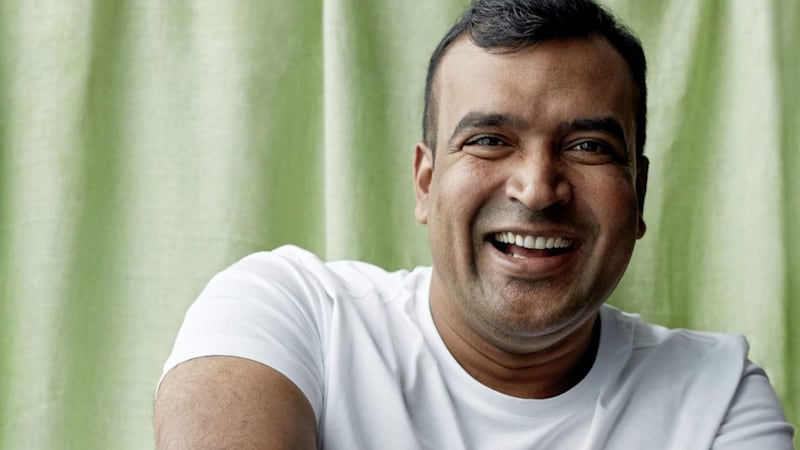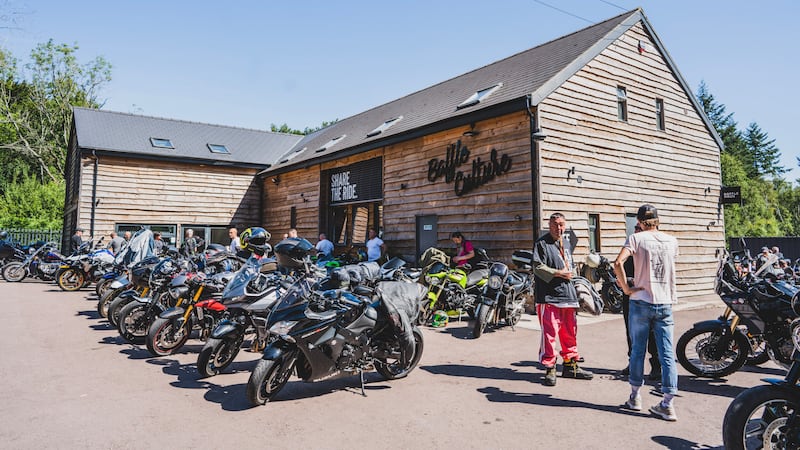MasterChef: The Professionals fan favourite Santosh Shah is back with his debut cookbook. Lauren Taylor finds out all about it.
For many viewers, it was Santosh Shah who first introduced them to fine dining Nepalese food on MasterChef: The Professionals 2020. But, despite being from Nepal, he had only recently discovered the food of his home country himself.
Having left his village of Karjanha and family at just 14 to move to India and work as a kitchen porter, he progressed to chef, and Indian food was what he cooked – and what he knew – for 20 years.
“Before I was calling [myself] an Indian chef,” Shah says.
“What do you cook? Indian food. Where do you work? Indian restaurants. What kind of chef are you? I’m an Indian chef.”
But before his stint on BBC’s MasterChef, he started to research the cooking techniques and produce of Nepal, and the experience has been a real homecoming to the food he once cooked with his mother as a child.
“I was so amazed with the cooking and food we have… from the fermentation to pickling, the dumplings, the bread, high-altitude food, low-altitude food, fire cooking, lots of meat, lots of fish,” he says. “I’m thinking, why didn’t I do this before?
“Now, no, no more – everything Nepali. I’m a Nepali chef. What do you cook? Nepalese food.”
He’s on a mission to “contribute Nepalese food to the world” via his debut cookbook, Ayla, and plans to open a fine dining Nepali restaurant in London.
There’s a misunderstanding, he says, that Nepalese food is very similar to Indian, which borders three sides of the country. “It’s totally different. India is such a big country – even one state is bigger than Nepal,” he says, and if you’re a small country next to a big country, you’re always going to be subject to their stature.
Of course, some influence does come from its neighbours, which also include China (the Tibet region borders the north side of Nepal), Pakistan, Burma and Bhutan, Shah explains. But the secret is really in Nepal’s unique geography and biodiversity.
“Where I come from, the Siraha region, it would be 25C now, and if I travelled north 100km, it would be minus [temperatures]. So you can imagine, 100km from every part of Nepal, what food is growing, the vegetables, the meat, everything is changed.”
From the arid high altitudes of the Himalayas, to the band of rich green valleys and rivers, and the tropical grasslands of Terai in the south, the crops and livestock farmed are diverse. A largely Hindu country with at least 123 languages spoken, “every community has different food, different ingredients and a different way to make flavour,” Shah says.
But whether it’s street food (“a way of life in Nepal”) like kukhura ko momo (steamed chicken mo mo dumplings) or festival specialities like terai malpua ra rabri (syrupy pancakes with saffron creamy milk), you can be sure of the sophisticated use of spices.
What surprises a lot of people is, for a landlocked country, there is a huge fish cookery culture. “People say, ‘Do you really have a lot of fish?’ Yes we do – big fish, small fish, so tasty,” Shah says with a laugh. Water running down from the Himalayas means river fish are not only in abundance, but many species are indigenous to Nepal.
Rohu is the most famous, but the firm texture of monkfish makes a perfectly good substitute for home cooking in the UK, for Shah’s poleko machha ra jhol (spiced monkfish with sesame and tomato sauce) recipe, for example.
And while his book celebrates the wild boar, buffalo meat and jungle fowl that’s so crucial to Nepali cuisine, they can all be substituted for easier-to-source meats, he says.
Fermentation, pickling and sun-drying, meanwhile, are processes born out of necessity in Nepal. “Even in my village, 10 or 11 years ago, they didn’t have electricity, so we didn’t have a freezer to keep anything in,” Shah explains. It’s also important during monsoons, which can have a devastating effect on agriculture in the south. Gundruk, made using mustard leaves, is the country’s most famous preserve, and you’ll find it dotted through Shah’s recipes.
The MasterChef: Professionals finalist – who also won MasterChef: The Professionals Rematch Special in 2021 – has come a long way from his early childhood in Karjanha.
“When I was young, everybody had to cook at home. I’m from a very poor family background, we had one big room, there was a kitchen in a corner, in another corner there was a bed – like a studio flat here,” he says. But there was a lot of people in that one space – Shah is the youngest of seven siblings.
“I have five brothers and two sisters; when everybody got married and left the village, my mother was there cooking and I was always next to her, [she’d say] ‘Cut this one, cut that one’.
“In Nepal, if you are poor then you have a vegetable garden. Rich people buy from the market, poor people grow their own. So we had everything in our garden. Whenever my mother was cooking, I would go and pick [vegetables] from the backyard, come into the kitchen and wash them with my mother,” he recalls.
After finishing school at 14, he didn’t have the money to go any further in education, heading for the bright lights of India instead.
“I was amazed to see that big hotel, that many people working as chefs, the kitchen, everything,” Shah says.
After six months, he asked the head chef for a chance to cook and that’s when his culinary journey really took off – moving to the UK in 2011, where one of his first jobs was at Brasserie Blanc, owned by Raymond Blanc, before working at Michelin-starred Benares, becoming head chef at Cinnamon Kitchen and executive chef at the five-star LaLit Hotel in London.
“I love cooking. Apart from cooking, I don’t know anything,” he says, with that jolly laugh you can’t mistake.
Ayla: A Feast Of Nepali Dishes From Terai, Hills And The Himalayas by Santosh Shah is published by DK, priced £20. Available now. Below are three recipes to try at home...
THUKPA – SHERPA NOODLE SOUP
(Serves 4)
100g soba noodles, or egg noodles
3tbsp vegetable oil
½tsp hing (asafoetida)
300g free-range chicken breast, finely chopped
½tsp ground turmeric
50g finely chopped carrots
180g finely chopped mixed peppers
50g thinly sliced green French beans
80g finely shredded white cabbage
1tsp salt
800ml chicken stock
2tbsp fresh coriander, chopped
1 lemon, quartered, to serve (optional)
For the spice paste:
1 large garlic clove
4tsps finely chopped fresh ginger
4 fresh green chillies, roughly chopped
½tbsp cumin seeds, dry roasted
5 Sichuan peppercorns or timmur peppercorns (timmur is native to Nepal and is a cousin of the Sichuan peppercorn)
¼tsp black peppercorns
1tbsp fresh coriander, chopped
1 small tomato, deseeded and chopped
Method:
Start by making the spice paste. Place all the ingredients for the spice paste except the tomato in a small food processor or electric spice grinder. Blend until you get a paste. Add the chopped tomato and blend again. You should get a smooth, spoonable paste. You can make this paste in advance and keep it in the refrigerator for two to three days, or in the freezer for one month.
Cook the noodles according to the packet instructions and set aside.
Heat the oil in a large saucepan over medium heat. Stir in the hing and cook for a few seconds. Add the chicken and cook for five minutes, until slightly golden. Add the turmeric and cook for one minute.
Add all the vegetables and stir-fry for a couple of minutes. Stir in the salt and spice paste until all the ingredients are well coated. Cook for a couple of minutes.
Pour in the chicken stock, bring to the boil, reduce the heat and simmer for five minutes. Add the noodles and cook for a couple of minutes, just enough to reheat them.
Adjust the seasoning to taste, add the chopped coriander and serve with lemon quarters for squeezing over.
HARIYO AAP RA NARIYAL KO ACHAR – GREEN MANGO AND COCONUT CHUTNEY
(Makes 4-6 servings)
4 small green mangoes
½tsp salt
½tsp Kashmiri chilli powder or medium hot chilli powder
4 garlic cloves, chopped
15g fresh ginger, peeled and chopped
50g grated fresh or frozen coconut
1tbsp caster sugar
1tbsp lemon juice
1tbsp fresh coriander leaves
2tbsp vegetable oil
An airtight container, for storing
Method:
Peel and stone the mangoes and cut the flesh into a small dice. Crush the mango pieces and salt in a large pestle and mortar to break them up. Add the rest of the ingredients and crush into a paste. Alternatively, place the mango pieces and salt in a food processor and pulse a few times, until slightly crushed. Add the rest of the ingredients and process to a coarse paste.
Check and adjust the seasoning, adding more salt, sugar or lemon juice, to taste. Stored in an airtight container and refrigerated, this will keep for three to four days.
CHANA KO DAL – SPICY CHICKPEAS
(Serves 4)
280g chana dal (split Bengal gram)
½tsp ground turmeric
2–3 whole fresh green chillies, tailed and slit lengthways
3–4 cloves
2.5cm piece of cinnamon stick
2–3 green cardamoms, lightly crushed
2 tejpaat (Nepali bay leaves)
1tsp salt
1tbsp fresh coriander leaves, chopped
For the tempering:
2tbsp ghee or vegetable oil
2–3 dried red chillies, depending on size or to taste
1tsp cumin seeds
2 red onions, finely chopped
15g fresh ginger, peeled and finely chopped
1 tomato, chopped
1tsp sakahar barha masala (vegetable garam masala, see below)
For the Sakahar barha masala:
For the whole spices:
1tbsp dried garlic flakes
5 dried red chillies, crushed
2tsp cumin seeds
2tbsp coriander seeds
1¼tsp black mustard seeds
1tsp fenugreek seeds
1tsp timmur peppercorns, or Sichuan peppercorns
2tsp black peppercorns
4 black cardamoms
5 tejpaat (Nepali bay leaves), crushed
For the ground spices:
1tbsp ground ginger
1tsp turmeric
1tsp hing (asafoetida)
To serve:
Bhat (plain rice)
Puri (fried puffed bread)
Method:
Make the Sakahar barha masala: Heat a non-stick frying pan. Add all the whole spices and dry roast over a medium heat until they colour, puff up and start releasing their aroma. Transfer to a plate and leave to cool. Using a spice grinder or coffee grinder, grind the toasted and cooled whole spices in batches until finely powdered. Mix in the ground spices until well blended. Transfer to a screw top jar or other airtight container. For best results, use any leftover spice mix within two weeks.
Wash the chana dal under running water and soak them for 30–60 minutes in lukewarm water.
In a medium heavy-based saucepan, combine the drained chana dal, turmeric, fresh green chillies, whole spices and salt. Cover with 1.4 litres of water and bring to the boil.
Lower the heat and simmer, uncovered, for 45–60 minutes, until the dal is cooked through, and the liquid has reduced. Drain half of the dal and place in a blender with some of the cooking liquid. Process to a purée and pour back into the pan. Stir until well blended. The dal should have the consistency of a thick soup. Keep the dal hot.
Make the tempering. Heat the ghee or oil in a non-stick frying pan, add the dried red chillies and cumin seeds.
When the seeds start to crackle, add the onions and cook for 12–15 minutes, stirring occasionally, until caramelised. Stir in the ginger and tomato. Cook for two minutes, until the tomato is soft. Add the vegetable garam masala, stir well and leave to simmer for 30 seconds.
Pour the whole tempering mixture into the simmering dal, add the chopped coriander and stir until well mixed. Simmer for three to four minutes, to allow the flavours to infuse.
Check and adjust the seasoning to taste, adding more salt if needed, and serve hot with rice and puri.



